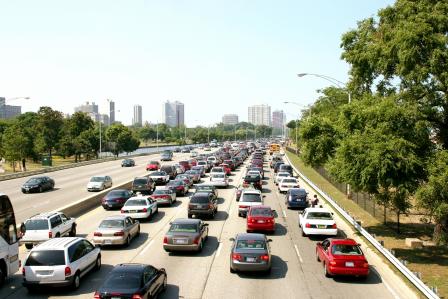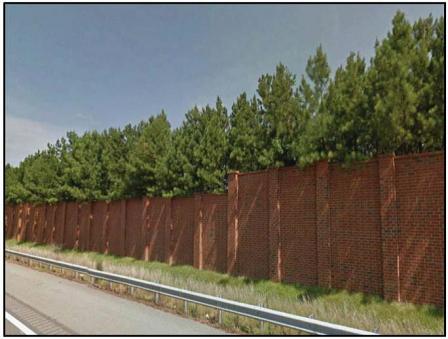Living Close to Roadways: Health Concerns and Mitigation Strategies
Published January 10, 2017.
Every day, millions of Americans that live, work, and go to school near a major roadway or train, bus, or railyard station, come into contact with traffic-related air pollution. Exposure to emissions from cars and trucks can have negative effects on health. That’s why EPA is developing strategies to reduce the impact of traffic emissions on public health.
 EPA scientists have compiled research and recommendations for designing and planting roadside barriers in the recent report Recommendations for Constructing Roadside Vegetation Barriers to Improve Near-Road Air Quality. Roadside barriers can be walls built alongside roadways to reduce traffic noise, and vegetation made up of trees and bushes that are along the road. Study findings show that properly designed roadside vegetation and noise barriers can reduce downwind pollution concentrations near roadways by altering air flow and intercepting pollution. Roadside vegetation can be most effective at reducing air pollution when barriers are thick, with full coverage from the ground to the top of the canopy, and extend or wrap around an area, so that pollutants cannot flow around the edges.
EPA scientists have compiled research and recommendations for designing and planting roadside barriers in the recent report Recommendations for Constructing Roadside Vegetation Barriers to Improve Near-Road Air Quality. Roadside barriers can be walls built alongside roadways to reduce traffic noise, and vegetation made up of trees and bushes that are along the road. Study findings show that properly designed roadside vegetation and noise barriers can reduce downwind pollution concentrations near roadways by altering air flow and intercepting pollution. Roadside vegetation can be most effective at reducing air pollution when barriers are thick, with full coverage from the ground to the top of the canopy, and extend or wrap around an area, so that pollutants cannot flow around the edges.
Communities can use roadside vegetation barriers in different ways. Using a vegetation barrier may remove some of the smallest particulate pollutants from the near-road environment. Other research suggests that combining roadside vegetation with noise barriers can reduce downwind pollution at a greater rate than vegetation or a solid, noise barrier alone.
“These roadside barriers can be a good addition to emission control techniques because they can address existing air quality problems in a shorter time period than most other strategies,” says Richard Baldauf, an EPA scientist who studies mitigation strategies for near roadway air pollution. “Noise barriers and vegetation barriers can also provide other benefits to the community such as noise reduction and water runoff control.”
 Vegetation and noise barrierEPA developed these recommendations to help support two communities in building and evaluating the capabilities of vegetation barriers. Two locations were selected based on their proximity to major roadways with significant diesel traffic: an elementary school in Oakland, California, and a community park in Detroit, Michigan. Partners leading the planting of the vegetation barrier include Urban Releaf and the Bay Area Air Quality Management District in Oakland and The Greening of Detroit and Departments within the City of Detroit for the community park there.
Vegetation and noise barrierEPA developed these recommendations to help support two communities in building and evaluating the capabilities of vegetation barriers. Two locations were selected based on their proximity to major roadways with significant diesel traffic: an elementary school in Oakland, California, and a community park in Detroit, Michigan. Partners leading the planting of the vegetation barrier include Urban Releaf and the Bay Area Air Quality Management District in Oakland and The Greening of Detroit and Departments within the City of Detroit for the community park there.
These will be the first known studies to plant roadside vegetation for air quality mitigation. Previous studies used existing vegetation to conduct research on near-road pollutant concentrations. These studies are bringing together community organizations, local agencies, and EPA to design, plan, and measure air quality before and after the planting of the vegetation.
The highway near the elementary school is bordered by a noise barrier and provides an opportunity to investigate the ability of noise and vegetation barriers used together to reduce pollution. The location of the park offers the opportunity to compare the performance of a noise barrier with vegetation to a vegetation barrier alone.
Near-road mitigation strategies can be critical to reducing traffic-related pollutants and protecting the public from air pollution. EPA is expanding its air pollution research to include other sources besides major roadways, such as rail yards, ports, and wildfires, that can impact air quality in a community. New studies are characterizing the sources of air pollution, determining how they are dispersed, identifying their health impacts, and evaluating ways to reduce their impacts on communities. This work will help support EPA in its mission to reduce the health impacts of air pollution.
Learn more:
- Research on Near Roadway and Other near Source Air Pollution
- Recommendations for Constructing Roadside Vegetation Barriers to Improve Near-Road Air Quality
- Near roadway Air Pollution and Mitigation Strategies Webinar Presentations
- Best Practices for Reducing Near-Road Air Pollution Exposure at Schools
- Smart growth
- Healthy Heart Toolkit and Research
- Asthma Research
